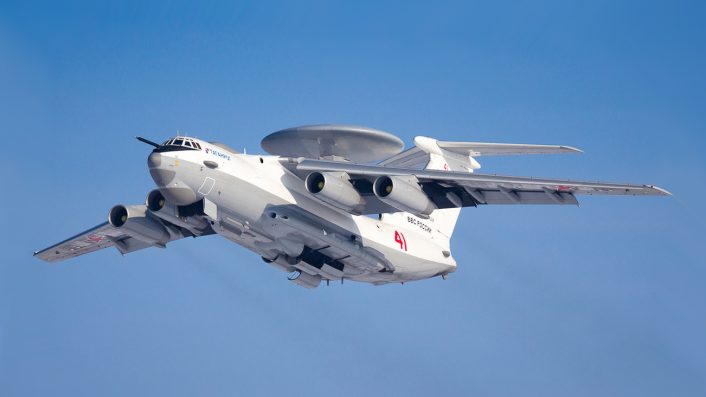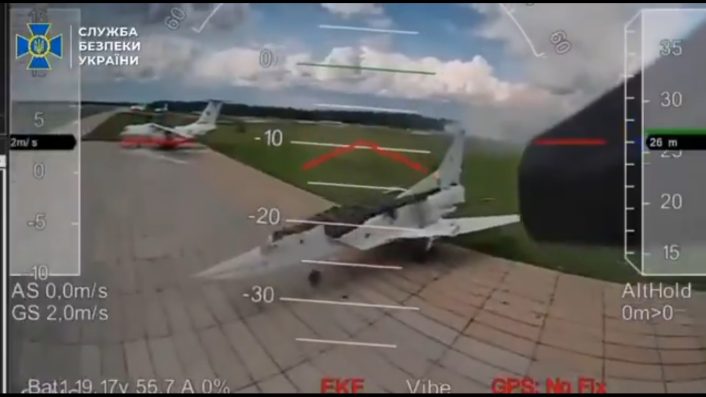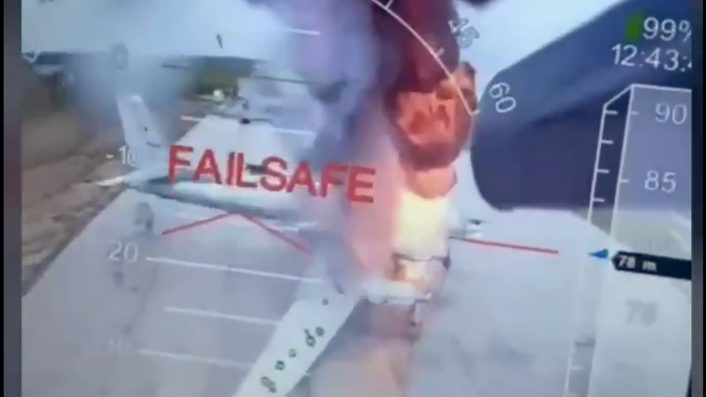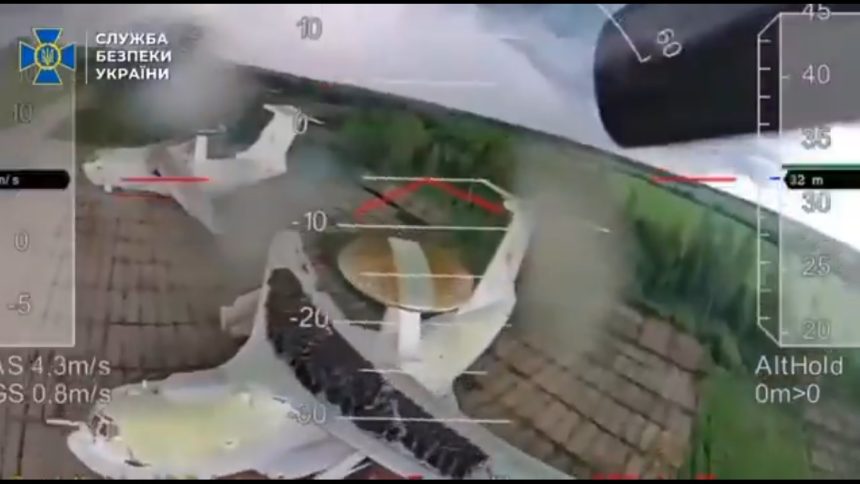During the massive June 1 attack, Ukrainian First Person View drones also hit two A-50U Mainstay Airborne Early Warning aircraft.
Few days after the daring long-range attack against Russian air bases, Ukraine has now released new videos from the attack on Jun. 1, 2025. One of these, part of a 5 minute compilation, shows First Person View (FPV) drones landing on the radar dome of two A-50U Mainstay Airborne Early Warning and Control (AEW&C) aircraft before exploding.
The General Staff of the Armed Forces of Ukraine (AFU) mentioned after the attack that A-50, Tu-95 and Tu-22 M3 aircraft were hit, but the videos released so far only showed Tu-95 bombers and one An-12. Using the available data, OSINT analysts verified that seven Tu-95s and four Tu-22Ms were destroyed, as well as an An-12.
Changing status of An-12 from Olenya part two and remaining “burning” Tu-95 from Olenya part one at 68.144249, 33.448926 to destroyed.
Current totals visually verified thus far:
Tu-95s: 7 destroyed
Tu-22Ms: 4 destroyed
An-12: 1 destroyedhttps://t.co/keapL87Unq
— Evergreen Intel (@vcdgf555) June 3, 2025
Andriy Kovalenko of the Ukrainian Center for Countering Disinformation claimed on June 1 that “at least 13 Russian aircraft have been destroyed, and more have been damaged.” However, on June 3, the General Staff of the AFU once again claimed that 41 aircraft have been destroyed.
The new videos now show multiple aircraft types being hit by the drones, including seven Tu-95s, one An-12, two A-50Us and 12 Tu-22s. Some of these aircraft are covered by tires, but it is unclear how much protection they could provide. In fact, as previously mentioned, the drones aimed for precise areas: fuel tanks and external weapons (one video clearly shows the drone going for a Kh-101 cruise missile under a Tu-95’s wing).
Operation “Spiderweb”@ServiceSsu has released unique footage of an operation that resulted in the damaging of 41 russian strategic military aircraft. pic.twitter.com/S4C8bSJRAV
— Defense of Ukraine (@DefenceU) June 4, 2025
A shorter, 3 minute video, was provided in advance to The Telegraph, which first verified the strike of the two A-50Us. A day later, the longer 5 minute video was published freely online, although it is not really clear which are the parts missing from the 3 minute video.
With the new videos now showing more strikes, OSINT analists are already at work to provide an updated count of the aircraft damaged and destroyed. High-resolution commercial satellite images are now being published, showing in greater detail the aftermath of the attack and allowing a more precise evaluation of the damages.

From the videos it is not clear how extensive is the damage to the two A-50Us. However, it appears that the drones struck its most sensitive area: the radar dome on top of the fuselage, where the drones appear to have landed before exploding.
Interestingly, as also noted by The Telegraph, it appears that the two aircraft might be the same shown in commercial satellite images taken by Maxar Technologies on May 3, 2025. The same images, taken a month before the attack, are being used to claim that no A-50 was damaged in the attack.
Pro-Kremlin users are claiming this Maxar satellite image of two Russian A-50 planes at the Ivanovo air base is recent and refutes Ukrainian claims that their drones successfully targeted A-50s.
But the Maxar satellite image was captured on 3 May, before Ukraine’s drone attack. https://t.co/Heb60YAXid pic.twitter.com/lxZvmuhiRP
— Shayan Sardarizadeh (@Shayan86) June 3, 2025
It is worth noting that it is unclear if the airframes shown in the video being struck by the drones were operational or in storage. However, even if they were in storage, the attack would still be important as it would make unavailable a source of spare parts for the few A-50Us in service, making maintenance more difficult and drastically lowering the availability of the AEW&C aircraft.
Comparing the May 3 satellite photos and the June 1 videos, it appears that the radar domes and the tires positioned on the aircraft are in different positions. This detail, however, can not be considered as a conclusive proof whether the aircraft is operational or not.
A-50U Mainstay
The A-50 Mainstay is Russia’s Airborne Early Warning and Control (AEW&C) aircraft, which first entered service in 1985. A total of 42 aircraft were built before the collapse of the Soviet Union.
In the early 2000s, work started to develop the upgraded A-50U variant, of which eight units were produced. Since 2023, the aircraft has been employed in support of the war in Ukraine, with two aircraft lost to Ukrainian air defenses.
Here’s what we wrote when an A-50U Mainstay was shot down on Jan. 15, 2024:
The Beriev A-50 Mainstay is an incredibly important asset in the Russian Aerospace Forces inventory. It’s an Airborne Early Warning and Control aircraft, used for long range radar detection and surveillance roles. One A-50U was deployed to the Machulishchy Airbase, Belarus in January 2023. Although on Feb. 26, 2023, the Belarusian partisan group, BYPOL, carried out a drone attack on the radar jet that caused some damage to the aircraft on the ground, the A-50 has remained quite far from the front line until November 2023, when the UK MOD reported that Russia, for the first time, had started using its Airborne Early Warning and Control aircraft, to identify targets over Ukraine for its SA-21 long-range ground-based air defence missile system, adding to the Mainstay’s core mission of co-ordinating fighter aircraft.
“Compared to SA-21’s usual ground-based radar, MAINSTAY can use its radar to spot adversary aircraft at longer ranges because its altitude allows it to see further around the curvature of the earth. Russia has likely expedited integrating MAINSTAY and SA-21 partially because it is concerned about the prospect of Ukraine deploying Western-provided combat aircraft.”
In order to carry out the new mission, “there is a realistic possibility that Russia will accept more risk by flying MAINSTAY closer to the front-line in order to effectively carry out its new role,” the British intelligence report hightlighted.

Recap of the June 1 attack
In an audacious and meticulously coordinated operation named “Spiderweb,” Ukraine’s Security Service (SBU) launched an unprecedented drone strike deep inside Russian territory, culminating what has been described as a year and a half of covert preparation. The attack, involving 117 First Person View (FPV) drones, targeted multiple strategic airbases across Russia and is claimed to have inflicted substantial damage on long-range bomber fleets.
President Volodymyr Zelenskyy characterized the mission as Ukraine’s “most long-range operation,” claiming it hit 34% of Russia’s strategic cruise missile carriers. It is currently not possible to verify how many aircraft were destroyed and how many were damaged.

The operation was made possible by covert Ukrainian teams operating within Russia. Drones were smuggled into the country and then concealed within modified truck containers. Once positioned near airbases, the drones were deployed.
Targets included Belaya, Dyagilevo, Ivanovo, Olenya, and Ukrainka airbases, although the latter was not successfully attacked as the truck transporting the drones reportedly exploded. Viral drone footage circulating online showed multiple Tu-95 bombers being precisely hit at vulnerable points such as fuel tanks and externally mounted weapons.

Russian responses varied, with the Ministry of Defense confirming attacks at several airfields, stating that while some aircraft caught fire, no casualties were reported and many attacks were “repelled.” However, satellite imagery and OSINT analysis suggest otherwise.
In fact, independent analysts verified the destruction of at least seven Tu-95s and four Tu-22M3s, with additional aircraft damaged. Ukrainian claims of 40 total aircraft losses are still under review, though even conservative estimates suggest a significant blow to Russia’s strategic airpower.









